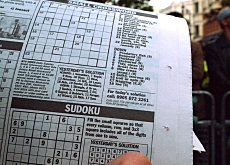World honours sum total of mathematical genius

Leonhard Euler, who was born in Basel 300 years ago this month, left his mark on the world in more ways than can be imagined.
Yet few non-mathematicians would know that his ideas underpin the Swiss Federal Railways’ famously efficient timetable, the success of the Swiss yacht Alinghi – winner of the America’s Cup – and sudoku.
“Many items in our everyday life have Euler hidden in them somewhere,” said Professor Peter Buser of the Swiss Mathematical Society.
His birth on April 15, 1707, and his contribution to the way we live are being celebrated this year not only in Switzerland but also all over the world.
Euler had an astonishing ability to abstract the general mathematical principles behind the solutions to concrete problems. The same principles can then be applied to a range of applications, many of which would have been quite unimaginable in the 18th century.
For example, from the simple problem of why it is impossible to walk to all four districts of Königsberg without crossing one its seven bridges twice, he developed the principles of graph theory, used today in Operations Research to solve problems of timetabling and logistics.
He came up with the formulae still used today in areas as diverse as bridge building, aircraft and ship design and the encoding of information.
Intellectual powerhouse
Euler was born in Basel, the son of a pastor. At the time Basel was an intellectual powerhouse and it was his good fortune that the great Bernoulli dynasty of mathematicians was based there.
Mathematics was a poor relation among school subjects, but Johann Bernoulli himself agreed to help the young Euler with his studies, and quickly recognised his protégé’s extraordinary ability.
Euler first came to international attention with a paper he submitted for the prestigious Paris Academy prize in 1727. It dealt with the most efficient way to mast ships – not an obvious subject for a teenager who had never seen the sea. He didn’t win; but he did come second.
That same year, however, having failed to gain a professorship in Basel, he left his home town, following his friends Daniel and Niklaus Bernoulli – the sons of his mentor – to the new Academy of Science in St Petersburg.
He stayed there until 1741, when he moved to Berlin. But after 25 years in Prussia he returned to St Petersburg, where he lived until his death.
Groundbreaking papers
His output and his range of interests were prodigious. Despite losing the sight of one eye at the age of 31 and going blind in 1766, he continued to turn out groundbreaking papers and books. He wrote letters to scholars all over Europe till the end of his life in 1783.
Euler was a mathematician of genius, but he did not address himself only to other mathematicians. He wrote textbooks; many of the mathematical symbols – like pi – which we take for granted today were popularised by him.
But the best selling of all his books, soon translated into several languages (including English) was “Letters to a German Princess”, a work of popular science, first written for a young niece of Frederick II of Prussia.
Euler was widely admired not only for his genius, but also for his geniality: he was quite unpretentious. “A child on his knees, a cat over his shoulders – that is how he wrote his immortal works,” according to one of his contemporaries in Berlin.
This most universal of men, who never returned to Switzerland after 1727, remained a fond Basler to the end of his life. He kept in touch with the informal Basel circle of mathematicians; he loved to speak Basel dialect, and he made sure that his family were granted citizen’s rights there.
His home city is honouring him with an exhibition at the University Library, lectures and competitions.
“We want everyone to know about him,” Dr Fritz Nagel, curator of the Euler exhibition told swissinfo. “And we want them to know that mathematics is everywhere – even where they don’t suspect it!”
swissinfo, Julia Slater
Although Euler never returned to Switzerland after leaving for Russia, the Swiss still proudly claim him as one of their own – he used to be the face of the SFr10 ($8) note.
The mathematician died in 1783, the year he devised his carrés magiques (magic squares). These 81-square grids were the proto-sudoku puzzles.

In compliance with the JTI standards
More: SWI swissinfo.ch certified by the Journalism Trust Initiative

You can find an overview of ongoing debates with our journalists here. Please join us!
If you want to start a conversation about a topic raised in this article or want to report factual errors, email us at english@swissinfo.ch.